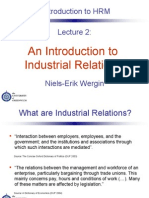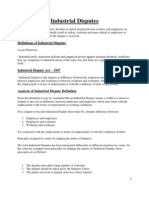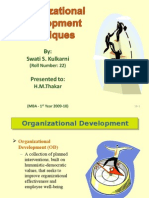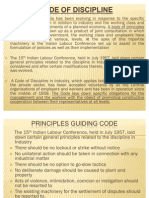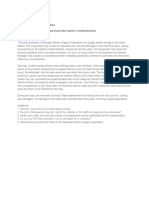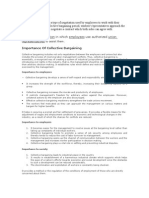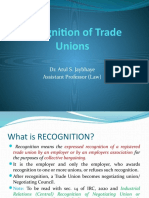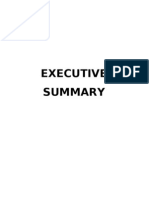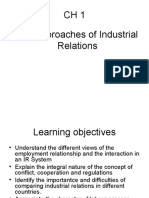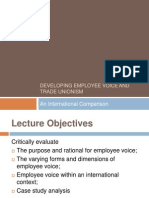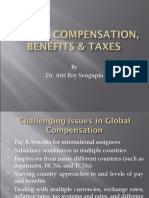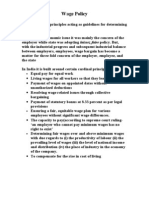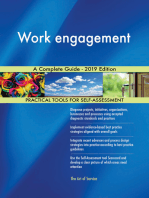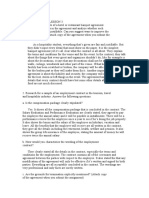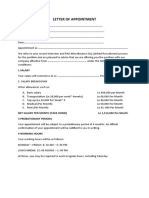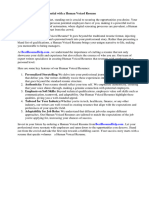Elements of A Sound Industrial Relations
Elements of A Sound Industrial Relations
Uploaded by
Ajith VenugopalCopyright:
Available Formats
Elements of A Sound Industrial Relations
Elements of A Sound Industrial Relations
Uploaded by
Ajith VenugopalOriginal Description:
Original Title
Copyright
Available Formats
Share this document
Did you find this document useful?
Is this content inappropriate?
Copyright:
Available Formats
Elements of A Sound Industrial Relations
Elements of A Sound Industrial Relations
Uploaded by
Ajith VenugopalCopyright:
Available Formats
MANAGEMENT PRACTICES Two theories First one viewed the worker as a mere cog in the organisational structure.
e. The other theory is just opposite The two realities of that theory is the dependency of every manager on people under him and the potential of people to be developed to match organisational goals
The present trend in labour relations and HR is to place greater emphasis on employee involvement, harmonious employee-employer relations and mechanisms and practices to promote them.
The focus on relations external to the enterprise is through collective bargaining in the national and industry level. It reduces competitive advantage based on labour cost. Labour problems are occuring not only because of the conflict between employers and employees
Low productivity, absenteeism, high labour turnover, lack of job security, lack of motivation etc. Corrective measures such as recruitment and selection, leadership and motivation etc should be taken. Economics and law and psychology and behaviour influences the industry relations.
Establishment of sound industry relations system is the central theme to achieve economic and social development. Many countries are undergoing the process of restructuring. Another feature is the change occuring in the workforces, to varying degrees, in both industrialised market economies and developing economies.
It is the one in which relationships between management and employees on the one hand, and between them and the state on the other, are more harmonious and cooperative than conflictual and creates an environment conductive to economic efficiency and the motivation, productivity and development of the employee and generates employee loyalty and mutual trust.
It operates at different levels National level- policy Industry level- collective bargaining between employers organizations and unions. Enterprise level- employers and workers are more direct, but the interest of workers may be represented by unions.
A sound industrial relations system requires a labour management relations policy (LMRP). There are many specific objectives of such policy , all of which go to make up the policy at the national level.
The following are some objectives:
Employment and job security and increased
employment opportunities. Raising living standards through improved terms and conditions of employment. Productivity improvement which enables employees to be more competitive and to increase their financial capacity to raise the living standards of the employees. Minimizing conflict, achieving harmonious relations, resolving conflicts through peaceful means and establishing stable social relatons.
Labour management relations policy formulation is one of the significant tasks at the national level, and successful formulation and implementation can influence the labour relations climate at the industry and enterprise levels. Such policy formulation, however, can be formulated not only at the national level through a tripartite process, but also at the industry level on a bipartite basis as between employers and workers organizations.
It includes recognition of organizations of workers and employers as autonomous, independent bodies, subject neither to their domination by each other or by the government.
Tripartism is the process through which the foundation for a sound industrial relations system can be laid at the national level. Ideally, tripartism is the process where by the government ,the most representative workers and employees organizations as independent and equal partners, consult with their spheres of competence, and jointly formulate and implement national policies on such issues. At the national level the mechanisms and procedures could be either formal and institutionalized , or else informal and ad hoc.
Auxiliary Regulatory Restrictive
Auxiliary - It gives the support to the autonomous system of collective bargaining, its operation and observance of agreements.
Regulatory - Provide a set of rules governing the terms and conditions of employment and supplementing those created by the parties themselves. Restrictive It prescribes what is permitted or forbidden in industrial conflict with a view to protecting the parties from each other, and the public from both of them
To create the legal framework which is necessary for employers, workers, and their organizations to function effectively and as autonomous groups in IR systems. To prescribe the minimum terms and conditions of employment which should be observed by employers in the course of concluding business.
It is an instrument of social change. The laws should be permissible Over regulation create problems. Statute law
It has been established in several countries because the normal system of courts and the system of law they administer cannot adequately deal with labour relation issues, which require an equitable rather than a purely legal approach.
Quality of relations between employees and employers in an enterprise depends on the policies practices and procedures which existed the enterprise level to deal with both individual and collective issues, and promote labour management corporation.
Harmonious industrial relations are more likely to exist in an enterprise where HRM policies and practices are geared to proper recruitment and training, motivational systems, two-way communication, career development, a people-oriented leadership and management style, etc. Many of this HRM activities have an impact on the over all industrial relation climate in the enterprise.
The practice of HRM did not match the theories expounded, though in the 1990s more progress has been made in narrowing the gap between the theory and practices.
The workers participation model influence the unions Many of the countries are following the German model Various other forms are gaining recognition Greater worker involvement is to occur in the future for the following reasons:
Employees at all levels are acquiring higher educational qualifications and skills. Quality and productivity tend to increase when the employees are more involved in arriving decisions at the point of production. For effective decision making in modern enterprises there should be an information flow and analysis of data and information.
Work today requires and involves more interpersonal skills, greater coordination among workers and sharing of information. Enterprises which have moved beyond the stage of routine high volume production. Participation is a greater motivation tool.
Communication has a vital role. The performance of an organization is effected by the manner in which the organization communicates with its employees. One-way and two-way communication. Develop communication channels in both micro and macro level for effective communication.
An effective communication would: Create an atmosphere of trust, which is important to promoting increased productivity. Promote an atmosphere of intimacy and commitment to the group, which in turn would bind people together and prompt cooperation.
Promote integration of intimacy and trust. Promote participation, which involves common goals, teamwork, discipline or commitment and cooperation. Develop the skills and attitudes of the individual, engendering self-confidence and a sense of self worth. Create a high degree of consensus in decision making.
Small group activities Grievance procedures Suggestion systems Shop floor meetings Quality circles a small group which performs quality control activities in the workshop to which it belongs.
Collective Bargaining may take place at the national, industry or enterprise level. It could be said that collective bargaining is a means of settling issues relating to terms and conditions of employment. Labour and management, as autonomous interest groups, can and should jointly fix the rules of employment upon terms which represent an acceptable compromise between their competing interests.
It ensures the participation , it represents a significant advance over abusive and oppressive unilateral employer control. Collective bargaining, promotes democracy at the enterprise as well as at the national and the industry levels.
According to the ILO Convention No. 98 (1949):"Voluntary negotiation between employers or employers' organizations and workers organizations, with a view to the regulation of terms and conditions of employment by collective agreements."
I.
II.
III.
It is not equivalent to collective agreements because collective bargaining refers to the process or means, and collective agreements to the possible result, of bargaining. There may therefore be collective bargaining without a collective agreement. It is a method used by trade unions to improve the terms and conditions of employment of their members. It is a method which restores the unequal bargaining position as between employer and employee.
IV. It leads to an agreement it modifies, rather than replaces, the individual contract of employment, because it does not create the employeremployee relationship. V. The process is bipartite, but in some developing countries the State plays a role in the form of a conciliator where disagreements occur, or may intervene more directly (e.g. by setting wage guidelines) where collective bargaining impose on government policy. VI. Employers have in the past used collective bargaining to reduce competitive edge based on labour costs.
Support of the labour administration authorities is necessary for successful collective bargaining, and this implies that they will:Provide the necessary climate for it, e.g. provide effective conciliation services in the event of a breakdown of the process, and provide the necessary legal framework for it to operate in where necessary Not support a party in breach of agreements concluded in consequence of collective bargaining As far as is practicable, secure observance of collective bargaining agreements Provide for the settlement of disputes arising from collective bargaining if the parties themselves have not so provided
i.
ii. iii. iv.
Collective bargaining has the advantage that it settles issues through dialogue and consensus rather than through conflict and confrontation. Collective bargaining agreements often institutionalize settlement through dialogue. For instance, a collective agreement may provide for methods by which disputes between the parties will be settled. Collective bargaining is a form of participation. Collective bargaining agreements sometimes renounce or limit the settlement of disputes through trade union action or lock out. Therefore collective bargaining agreements can have the effect of guaranteeing industrial peace for the duration of the agreements
Collective bargaining has valuable by-products relevant to the relationship between the two parties. For instance, a long course of successful and bona fide dealings leads to the generation of trust. Collective bargaining usually has the effect of improving industrial relations.
Quality of Work Life (QWL) programmes aim at combating worker alienation, integrating workers and encouraging worker involvement in the enterprise. They also aim at increasing worker motivation and instilling a sense of responsibility as well as at changing work organization so as to reduce costs and increase flexibility.
The importance of human resources development is in dispute prevention and settlement. Many workplace problems and issues are the result of unsatisfactory supervisory management and the lack of awareness on the part of employees about the workings of the enterprise. Three important consequences flow from this:First, team work becomes the norm, and employees are able to support each other.
Second, it is easier to find career development opportunities within the firm. Consequently employees tend to look to the "internal labour market" rather than to the external labour market for their advancement. Third, employees are more amenable than otherwise to look for long term gains rather than short term ones.
Changing patterns of work (e.g. more homework, part-time work, sub-contracting) have created concerns for unions in particular. Job insecurity, social security and minimum conditions of work are some of them. Women:The increasing influx of women into workforces has raised issues relating to gender discrimination, better opportunities for them in relation to training and higher-income jobs and welfare facilities.
Migration:-
There is a large migration of labour from labour surplus to labour shortage countries in Asia. Social security for migrant workers is one of the ma or problems as many receiving countries do not extend the benefits of social security to them.
o
Human Resource Management:With increasing reliance by employers in Asia on human resource management as a means of enhancing enterprise performance and competitiveness, important consequences will arise for industrial relations and for unions.
You might also like
- Collective Bargaining, Strikes and The Quest For Industrial Peace in NigeriaDocument23 pagesCollective Bargaining, Strikes and The Quest For Industrial Peace in Nigeriafarad6a0% (1)
- Mandatory OvertimeDocument6 pagesMandatory Overtimeapi-402775925No ratings yet
- Introduction To Industrial RelationDocument16 pagesIntroduction To Industrial RelationSatyam mishra100% (3)
- Collective Bargaining Process (Final)Document23 pagesCollective Bargaining Process (Final)asadfarooqi410275% (8)
- HR Worker's ParticipationDocument51 pagesHR Worker's ParticipationnikjaisNo ratings yet
- Bipartite and TripartiteDocument6 pagesBipartite and TripartiteDeepika Govindarajan0% (1)
- Industrial Relations ManagementDocument169 pagesIndustrial Relations ManagementAnand Kumar100% (1)
- Industrial Relation PolicyDocument5 pagesIndustrial Relation PolicyGunjan BanerjeeNo ratings yet
- A Case Study On "Employees Relations"Document7 pagesA Case Study On "Employees Relations"Anonymous CwJeBCAXpNo ratings yet
- Industrial DisputsDocument15 pagesIndustrial DisputsSahiuddin TutulNo ratings yet
- Final PPT On OD TechniquesDocument18 pagesFinal PPT On OD Techniquesswatikool91% (11)
- An Introduction To Labour Relations November 2020Document64 pagesAn Introduction To Labour Relations November 2020Shante MorganNo ratings yet
- Industrial RelationDocument18 pagesIndustrial RelationRojalin NayakNo ratings yet
- What Is Meant by Industrial RelationsDocument7 pagesWhat Is Meant by Industrial Relationsfarad6aNo ratings yet
- Employee Life Cycle 1Document23 pagesEmployee Life Cycle 1kumari yogeshreeNo ratings yet
- Ethical CodeDocument13 pagesEthical Codejeegogoi100% (1)
- Case Study On Damodar Electric Supply CorporationDocument1 pageCase Study On Damodar Electric Supply CorporationhuziNo ratings yet
- IR Case StudyDocument2 pagesIR Case StudyNakul BahiyaNo ratings yet
- Collective Bargaining - Doc G2Document2 pagesCollective Bargaining - Doc G2Ankit Sinai TalaulikarNo ratings yet
- Industrial Relations and Labor Law Oct 2017 Module MaterialDocument247 pagesIndustrial Relations and Labor Law Oct 2017 Module Materialßlåçk AB ELNo ratings yet
- Importance of Industrial RelationsDocument2 pagesImportance of Industrial Relationsshashimvijay100% (1)
- Industrial RelationsDocument47 pagesIndustrial RelationsDr-Shefali GargNo ratings yet
- Union Management RelationshipDocument16 pagesUnion Management RelationshipShabnam Habeeb100% (1)
- Trade Union-SEUSL-2Document41 pagesTrade Union-SEUSL-2dinukadamsith_287176No ratings yet
- Recognition of Trade UnionsDocument15 pagesRecognition of Trade UnionsHarsh Raj GuptaNo ratings yet
- Presentation On Employee RelationsDocument18 pagesPresentation On Employee RelationsNikhil ThakurNo ratings yet
- Collective Bargaining - ppt1Document15 pagesCollective Bargaining - ppt1Komal Madhan100% (1)
- International HRMDocument20 pagesInternational HRMAnamika Kumari100% (1)
- Industrial RelationsDocument98 pagesIndustrial RelationslovleshrubyNo ratings yet
- Workers Participation in ManagementDocument12 pagesWorkers Participation in ManagementParul MunshiNo ratings yet
- Approaches To Industrial RelationsDocument39 pagesApproaches To Industrial Relationslovebassi87% (15)
- Approaches To Industrial RelationsDocument6 pagesApproaches To Industrial RelationsRahul TRIPATHINo ratings yet
- Collective BargainingDocument28 pagesCollective Bargaining46 Kajal Priyadarshi100% (1)
- Employee VoiceDocument20 pagesEmployee Voiceanuradhak89100% (1)
- 3 Session 15 Pillar 01 Industrial RelationsDocument55 pages3 Session 15 Pillar 01 Industrial RelationsAzfah Ali100% (1)
- 1.4. - Labour Tribunal of Sri LankaDocument10 pages1.4. - Labour Tribunal of Sri Lanka21UG0740 DESHAN P.P.T.No ratings yet
- Labour LawDocument6 pagesLabour LawashNo ratings yet
- Employee Relation Management - Grievance Handling and Employee DisciplineDocument22 pagesEmployee Relation Management - Grievance Handling and Employee DisciplineMLANISA P.No ratings yet
- 1.overview of Industrial RelationDocument10 pages1.overview of Industrial RelationliyayudiNo ratings yet
- Industrial RelationsDocument6 pagesIndustrial RelationsSri LakshmiNo ratings yet
- Objectives of Industrial RelationsDocument2 pagesObjectives of Industrial RelationsNc SudarshanNo ratings yet
- Theories and Concepts Used To Analyse Industrial RelationsDocument13 pagesTheories and Concepts Used To Analyse Industrial RelationsAnup KumarNo ratings yet
- Layoff, Retrenchment & Closure: by Kanak Yadav Roll No. 0860Document13 pagesLayoff, Retrenchment & Closure: by Kanak Yadav Roll No. 0860Kanak YadavNo ratings yet
- Future of Organization Development (OD)Document14 pagesFuture of Organization Development (OD)DkdarpreetNo ratings yet
- Global Compensation, Benefits & TaxesDocument34 pagesGlobal Compensation, Benefits & TaxesSunny Deo Bhakta100% (1)
- Evolution of HRM: Emerging Trends in HRMDocument12 pagesEvolution of HRM: Emerging Trends in HRM08latika88No ratings yet
- Termination and Lay-Off BenefitsDocument3 pagesTermination and Lay-Off BenefitsMohamed ElsaiedNo ratings yet
- Types, Structure and Functions of Trade UnionsDocument19 pagesTypes, Structure and Functions of Trade UnionsMohit Sharma0% (1)
- 5 6273975324191490377 PDFDocument27 pages5 6273975324191490377 PDFSubhakanta SwainNo ratings yet
- Lecture 2, Challenges in SHRMDocument33 pagesLecture 2, Challenges in SHRMSrabon AhmedNo ratings yet
- Industrial Relations - Unit - 1Document7 pagesIndustrial Relations - Unit - 1ravideva84No ratings yet
- Employee Relations StrategiesDocument12 pagesEmployee Relations StrategiesRahman OluwaseyiNo ratings yet
- Wage PolicyDocument5 pagesWage PolicyrushtoruchikaNo ratings yet
- On HRM and Global EconomyDocument18 pagesOn HRM and Global EconomyAastha JainNo ratings yet
- Methods of Settling Industrial Disputes - FinalDocument14 pagesMethods of Settling Industrial Disputes - FinalRinpal75% (4)
- Motivation W.R.T Human Resource ManagementDocument17 pagesMotivation W.R.T Human Resource ManagementRahul Pinnamaneni100% (1)
- Emergence of Trade UnionismDocument40 pagesEmergence of Trade Unionismguruprasadmbahr7267No ratings yet
- The Future of Work: Adapting to the Rise of Automation and AIFrom EverandThe Future of Work: Adapting to the Rise of Automation and AINo ratings yet
- THE SUN 0742 FIN .CompressedDocument12 pagesTHE SUN 0742 FIN .CompressedMarius LambouNo ratings yet
- Presentation Lean Ops 2Document35 pagesPresentation Lean Ops 2Amanpreet kaurNo ratings yet
- Asgms ProfileDocument18 pagesAsgms Profileinfo.ppmajuresourcesNo ratings yet
- 2017 Labor Blue TipsDocument23 pages2017 Labor Blue Tipserikha_aranetaNo ratings yet
- 8th Semester 20th Lecture Resume and CVDocument15 pages8th Semester 20th Lecture Resume and CVShabeer MaheerNo ratings yet
- Legal AspectsDocument3 pagesLegal AspectsFRANCINE JANE ALEJONo ratings yet
- Salary Negotiation InformationDocument9 pagesSalary Negotiation InformationgangadharNo ratings yet
- Entrepreneurship Education: Paper 3Document4 pagesEntrepreneurship Education: Paper 3ankunda anthony67% (3)
- Naguiat vs. NLRCDocument64 pagesNaguiat vs. NLRCKharrel GraceNo ratings yet
- Letter of AppointmentDocument7 pagesLetter of AppointmentRaphael Emmanuel DeoudNo ratings yet
- Human Voiced ResumeDocument7 pagesHuman Voiced Resumef5dt39tp100% (2)
- Expenditure Switching PoliciesDocument5 pagesExpenditure Switching PoliciesAkashdeep GhummanNo ratings yet
- Pub Sippo Textile Short Mc12Document83 pagesPub Sippo Textile Short Mc12Iftekharul IslamNo ratings yet
- Tneb Apprenticeship ProcedureDocument6 pagesTneb Apprenticeship Procedurethangarajm1984No ratings yet
- Advanced Industrial RelationsDocument26 pagesAdvanced Industrial RelationsViraja GuruNo ratings yet
- Case Study-1Document3 pagesCase Study-1Tajrin Binte Alam 1631790630No ratings yet
- Best HR Practices of GoogleDocument7 pagesBest HR Practices of GoogleBoris Caesar M. BejeniaNo ratings yet
- Employer Branding: A Case of InfosysDocument6 pagesEmployer Branding: A Case of InfosysSamarendra ChakrabortyNo ratings yet
- Women in The U.S. Music Industry: Obstacles and OpportunitiesDocument39 pagesWomen in The U.S. Music Industry: Obstacles and OpportunitiesDiego TorresNo ratings yet
- KMJS Pumps Is An Authorized Distributor of Industrial PumpsDocument7 pagesKMJS Pumps Is An Authorized Distributor of Industrial PumpsShilca BarriosNo ratings yet
- HR Gd-Pi Guide: Compiled by HR DirectionDocument12 pagesHR Gd-Pi Guide: Compiled by HR DirectionPratik BafnaNo ratings yet
- Performance AppraisalDocument49 pagesPerformance AppraisalSai PrintersNo ratings yet
- Ch01 PresentationDocument35 pagesCh01 PresentationKarim WalidNo ratings yet
- Module III Cases-LaborDocument269 pagesModule III Cases-LaborIsabella IbarretaNo ratings yet
- Background Check - LEONEL-QUITODocument2 pagesBackground Check - LEONEL-QUITOLalaine QuitoNo ratings yet
- TONIDO, Sheila May Essay AssignmentDocument1 pageTONIDO, Sheila May Essay AssignmentthebeautyinsideNo ratings yet
- PAP STANDARD AgreementDocument9 pagesPAP STANDARD Agreementpratapanoop999090No ratings yet
- A Smarter Way To Network - Effective NetworkingDocument11 pagesA Smarter Way To Network - Effective NetworkingAnonymous Nb7QBE100% (1)
- Amazon Responds To Release of Leaked Documents Showing 150% Annual Employee TurnoverDocument6 pagesAmazon Responds To Release of Leaked Documents Showing 150% Annual Employee Turnoverroosevelt4085No ratings yet


